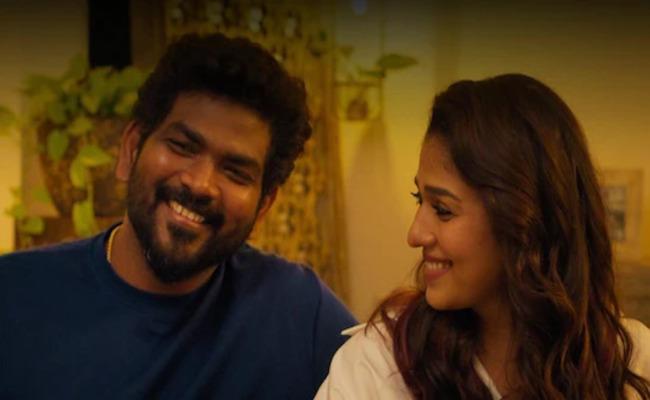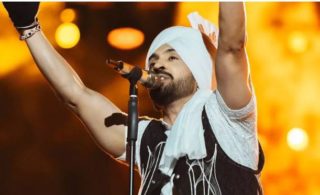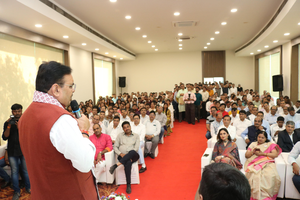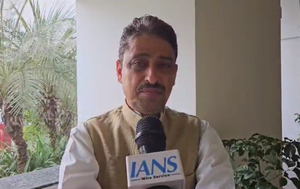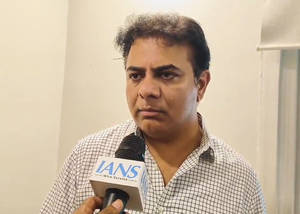 Ever since Narendra Modi came to power at the Centre for the first time in 2014, there has been a talk on simultaneous polls across the country.
Ever since Narendra Modi came to power at the Centre for the first time in 2014, there has been a talk on simultaneous polls across the country.
The strategy was obvious: to make hay while the sun shines. Its plan is to create a Congress-mukth Bharat and see that there will be BJP rule all over the country.
The only point that endorses the BJP’s argument is that simultaneous elections will bring down the election expenditure drastically.
It had no answer to several queries: what will happen if the governments in various states collapse mid-way without completing their five-year term due to fall in majority of the ruling parties on account of defections or dissidence. May be, the BJP had an idea of imposing President’s Rule for the remaining term.
Why alone states, even the Central government would have faced this situation had the BJP not secured absolute majority on its own and had its alliance partners in the NDA pulled rug from under its feet. Same would have been the case with the third front if it had got the razor thin majority.
We had seen how coalition governments of Janata Party, National Front, United Front and NDA had fallen like ninepins without completing their full terms due to rumblings among the alliance partners. So, what will happen if the Centre itself collapses?
Even before answers were found to these questions, nation had gone to general elections in April/May 2019. And Modi who returned to power with a massive mandate has started talking about simultaneous elections to Lok Sabha and state elections more vociferously.
Since the NDA gained enough strength in Rajya Sabha and it started getting the bills passed according to their whims and fancies, the situation has arisen to assume that the BJP might bulldoze this move of conducting simultaneous elections.
As a matter of fact, the RSS ideologues do not have faith in the federal system prevailing in India. They strongly desire that India should have a unitary rule in the entire country as was prevailing during the days of emperors.
They argue that the Delhi rulers should implement their agenda uniformly across the country. They don’t agree with the concept of unity in diversity. They strongly advocate a stronger centre with all decision-making authorities and states with nominal powers.
At least in the United States, there is a Congress which can have a check on the powers of President. But the RSS ideologues do not want even such a system here.
Modi belongs to this school of thought. That is precisely why he has been curtailing the powers of the states.
He wants to conduct simultaneous polls in the country, gain ultimate powers on the lines of US President and get the Constitutional amendment done to see that all the major powers are transferred to the states.
He has the ability to convince the people that such a step is required to make India stronger and secure nation.
For that to happen, the BJP has to first win the elections in all the states (or at least in 90 per cent of the states), apart from the Centre. At present, there is no leader who can match up to the stature of Modi in the country. There is no strong opposition party at the national level, except a few regional parties here and there.
Modi now has the support of corporate sector and also the media. There is a strong believe gaining ground in the country that whatever Modi does, it is in the national interest.
If at all anybody counters this argument with facts and figures, he is being branded as anti-national and such an atmosphere is widely prevalent across the country.
So, when everybody was under the impression that there is no better time than this for taking a decision on simultaneous polls, the latest election results gave some kind of a shock to the BJP. It looks certain now that the BJP might have second thoughts on simultaneous polls.
Modi, who spoke extensively over economic development and progress during the 2014 parliament elections, ignored the same in 2019. He brought to the fore a different agenda of hyper-nationalism by raking up issues like Balakot and Pulwama.
He deliberately suppressed the facts and figures with regard to financial position of the country. People had fallen into his trap and gave him more seats.
But after the BJP came back to power again, all the stats with regard to worsening economy of the country came out. Everybody came to know that people have lost their purchasing power and industries had been facing closure.
Yet, Modi and his accomplice Amit Shah strongly believed that they could bring the BJP to power in Maharashtra and Haryana by playing the nationalism card.
Instead of talking about local issues in the assembly elections, they gave extensive lectures on abrogation of Article 370, NRC etc.
Just a day before polling, they sent a message that India would attack on the terror camps in Pakistan-Occupied-Kashmir. Though there were defects in the regional leadership, disgruntlement among the voters, faults in the selection of candidates and disgusting political strategies, they believed that Modi would spin his magic web around the voters.
But, the outcome of the election results proved otherwise. Though it may take some time to make an analysis of the election statistics and the BJP is going to form the governments in both the states somehow or the other, but it is an undeniable fact that the BJP did not get the expected results.
In Haryana, the BJP had won all the 10 MP seats in the Lok Sabha elections and was leading in 79 assembly segments. All the bigwigs in the opposition had to bite the dust and it was expected that the BJP would win not less than 75 out of 90 assembly seats in the assembly elections. But it could win just 40 seats, which is almost half of the assembly segments it had won in Parliament elections. Compared to 2014, it had lost seven seats. What a difference in a span of five months?
Eight of the ministers in Manohar Lal Khattar lost their seats and Haryana BJP president, too, faced defeat. As if to teach a lesson to the BJP which vowed to achief Congress-Mukth Bharat, the Congress party had won 31 seats, 16 seats more than what it got in 2014.
While the BJP roped in stalwarts like Narendra Modi and Amit Shah into the campaign, the Congress had no such star campaigners, including Sonia Gandhi and Rahul Gandhi. Only local leaders had toiled day and night and won respectable numbers for the party. It clearly showed how the Congress has its vote bank intact at the grassroots level.
The BJP leaders were under the assumption that they had split the Jat community votes, Jananayak Janata Party (JJP) led by young and dynamic leader Dushyant Chautala won a good number of 10 seats.
The BJP leadership was forced to woo the JJP by offering it deputy CM post, besides seven other independent MLAs to form the government with great difficulty.
Coming to Maharashtra, there was a talk that Devendra Fadnavis was ruling the state excellently and his wave coupled with that of Narendra Modi would help the BJP storm the state once again.
To be on the safe side, the BJP entered into an alliance with Shiv Sena and engineered large scale defections from the Congress and NCP, making them virtually empty.
What is more, the BJP created troubles to every leader, starting from NCP chief Sharad Pawar to district-level leaders by foisting cases against them.
The Fadnavis government spent huge money in the name of developmental works to attract the voters. So, the BJP expected to win not less than 250 out of 288 seats, though conservative estimates put the BJP tally at 200-225. In the recent Lok Sabha elections, the BJP-Shiv Sena combine had won 41 out of 48 MP seats, accounting for 220 assembly seats.
But surprisingly, the final tally of the BJP-Sena combine was just 161. The BJP got just 105 out of 164 seats it contested, which is less than 17 seats it got in 2014; and Shiv Sena got just 56 seats (out of 126 seats it contested), seven less than its strength in 2014.
The Congress, which was travelling like a rudder-less ship, got 44 seats, two more than what it won in the last elections. And the NCP, which was completely down in the dumps under the leadership of ageing leader facing several cases, made a remarkable comeback with 54 seats, securing 13 more than what it got in 2014.
Many leaders who had defected from other parties into the BJP faced humiliating defeat. As many as nine ministers in the cabinet of Fadnavis, known for his efficient administration, lost at the hustings.
Taking advantage of their situation, Shiv Sena is now trying to call the shots, though it got just a few seats more than half of the BJP’s tally. It is trying to blackmail the BJP by demanding 50:50 share in power, realising that the former is banking on it for coming to power.
Not just these two states, there is nothing for the BJP to take pride in the by-elections held for 51 assembly seats across the country. It did not win any new seats but on the other hand, it lost a few seats in some places and managed to retain its seats in some other constituencies.
For example, an NCP leader who had won from Satara Lok Sabha constituency in Maharashtra in May later defected to the BJP, only to lose again in the hands of the NCP candidate. In Gujarat, the home state of Modi and Shah, the Congress won three out of six assembly seats for which by-polls were held.
Alpesh Thakur, who claimed credit for the commendable performance of the Congress in the last assembly elections, defected to the BJP before the Lok Sabha elections and lost to the Congress candidate in the assembly by-polls.
In Bihar, Janata Dal (U) of Nitish Kumar, a close ally of the BJP, faced a big debacle. Out of five assembly seats that went to by-polls in that state, the JD (U) lost four seats, including three of its sitting seats. Two seats were bagged by RJD of Laloo Prasad Yadav and another by an independent. In the fifth seat, Majlis-e-Ittehadul Muslimeen (MIM) won.
In Uttar Pradesh, by-elections were held for 11 seats, of which nine belonged to the BJP. But it could win only seven. The Samajwadi Party won two seats. In Rajasthan, the Congress wrested one of the two seats that went to bypolls.
In Punjab, too, the Congress won three seats, while Akali Dal could retain another seat. In Madhya Pradesh, the Congress wrested Jabhua seat from the BJP.
In Kerala, the BJP drew a blank, despite its desperate attempt to capitalise on Sabarimala agitation.
And in Telangana, the BJP which has been claiming to be the only alternative to the Telangana Rashtra Samithi, could not get even the deposit in Huzurnagar. In fact, the number of votes polled by the BJP candidate was not even equal to that of a ward member in a panchayat election.
What is the inference one can draw from these election results? It does not mean the opposition parties have grown stronger. The rural electorate wanted to teach a lesson to the BJP and hence, voted even for weaker opposition candidates.
Just like Brihannala enthused a timid Uttara Kumara, who fled the battle field on seeing the mighty army of Kauravas during Uttara Gograhana episode, the voters have breathed a new life into the Congress party which was almost slipping into a comatose state.
If the BJP can understand the thinking of the electorate, it cannot dare go in for simultaneous elections in the near future, at least till the political atmosphere in the country turns in its favour.
Recent Random Post:

